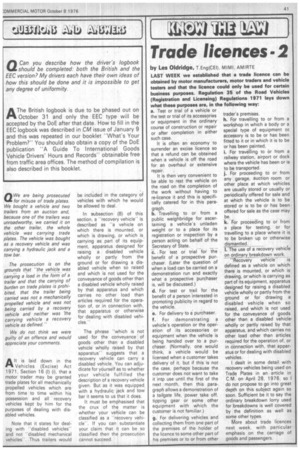Trade licences-2
Page 43

If you've noticed an error in this article please click here to report it so we can fix it.
by Les Oldridge, T.Eng(CEI), MIMI, AIVIIRTE
LAST WEEK we established that a trade licence can be obtained by motor manufacturers, motor traders and vehicle testers and that the licence could only be used for certain business purposes. Regulation 35 of the Road Vehicles (Registration and Licensing) Regulations 1971 lays down what these purposes are, in the following way: trader's premises. a. Test or trial of a vehicle or the test or trial of its accessories or equipment in the ordinary course of construction or repair or after completion in either such case.
It is often an economy to surrender an excise licence so that a refund can be obtained when a vehicle is off the road for an overhaul or extensive repair.
It is then very convenient to be able to rest the vehicle on the road on the completion of the work without having to re-licence it and this is specifically catered for in this paragraph.
b. Travelling to or from a public weighbridge for ascertaining a vehicle's unladen weight or to a place for its registration or inspection by a person acting on behalf of the Secretary of State.
c. For test or trial for the benefit of a prospective purchaser. (Later the question of when a load can be carried on a demonstration run and exactly what a prospective purchaser is, will be discussed.) d. For test or trail for the benefit of a person interested in promoting publicity in regard to the vehicle. . .
e. For delivery to a purchaser.
f. For demonstrating a vehicle's operation or the operation of its accessories or equipment when the vehicle is being handed over to a purchaser. (Normally, one would think, a vehicle would be licensed when a customer takes delivery of it, but if this is not the case, perhaps because the customer does not want to take it into use until the first of the next month, then this paragraph allows a demonstration of a tailgate life, power take off, tipping gear or some other equipment with which the customer is not familiar.) g. For delivering vehicles and collecting them from one part of the premises of the holder of the licence to some other part of his premises or to or from other h. For travelling to or from a workshop in which a body or a special type of equipment or. accessory is to be or has been fitted to it or in which it is to be or has been painted.
i. For travelling to or trom a railway station, airport or dock where the vehicle has been or is to be transported.
j. For proceeding to or from any garage, auction room or other place at which vehicles are usually stored or usually or periodically offered for sale and at which the vehicle is to be stored or is to be or has been offered for sale as the case may be.
k. For proceeding to or from a place for testing, or for travelling to a place where it is to be broken up or otherwise dismantled. •
I. The use of a recovery vehicle on ordinary breakdown work.
"Recovery vehicle.' is defined as a vehicle on which. there is mounted, or which is. drawing, or which is carrying as part of its equipment, apparatus designed for raising a disabled vehicle wholly or partly from the ground or for drawing a disabled vehicle when so raised, and which is not used for the conveyance of goods other than a disabled vehicle' wholly or partly raised by that apparatus, and which carries no other load other than articles required for the operation of, or in connection with, that apparatus or for dealing with disabled vehicles.
I dealt in some detail with recovery vehicles being used on Trade Plates in an article in C.M. on April 28, 1976, so I. do not propose to go into great depth on this subject again so soon. Sufficient be it to say the ordinary breakdown lorry used for breakdowns is well covered by the definition as well as some other types.
More about trade licences next week, with particular emphasis on the carriage of goods and passengers.




















































































